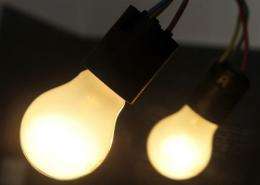Old-style 100-watt light bulbs will be banned in Europe's shops from next week in favour of new energy-saving models, but consumers groups have given the move a guarded welcome.
Old-style 100-watt light bulbs will be banned in Europe's shops from next week in favour of new energy-saving models, but consumers groups on Wednesday gave the move a guarded welcome.
From September 1, 100-watt versions of the old incandescent bulbs will be banned from Europe's shops and other bulbs with lower wattage will follow in the ensuing years, under a system agreed by EU experts last December.
New technology light bulbs, such as compact florescent lights (CFL) can save up to 80 percent of the energy used by the worst old-style lights in homes.
The move will also cut carbon dioxide emissions as part of the European Union's wider climate change package.
At the moment, around 85 percent of household lights are considered to use too much electricity.
The European Consumers' Association BEUC welcomed the phasing out of incandescent light bulbs, saying "consumers benefit financially from the measure, but most importantly, they will be able to contribute to improved energy efficiency."
However the group added, in a statement, that removing the old-style light bulbs from the market also holds drawbacks for some consumers.
There are concerns "about the risks to health from the high mercury content of the new bulbs," the group warned.
The EU plan also "falls short of the needs of some consumers who need to use the old-style light bulbs for health-related reasons such as light sensitivity," BEUC added.
The consumer group called on the European Commission to ensure that people who rely on incandescent light bulbs "will be able to buy these bulbs until suitable alternative lighting technologies are available".
"The benefits for both consumers and the environment are to be welcomed. However, further efforts are needed if the phasing-out of incandescent light bulbs is to run smoothly," said BEUC director general Monique Goyens.
Stephen Russell, secretary general of ANEC, which represents consumer interests on matters of EU standardisation, shared the fears over mercury levels.
"Although the current threshold is set at 5 mg of mercury per bulb, the best available technology enables the bulb to work with only 1-2 mg," he said.
He added that it should be made as simple as possible to recycle the obsolete bulbs after next week.
"Consumers should also have the possibility to return used bulbs to the point of sale without charge. Only in this way do we believe recycling can be made effective," he argued.
The consumer groups agreed that the new-style bulbs make huge energy savings and have a lifetime 8-15 times longer than the traditional kind.
Therefore, they argued, while the new bulbs may be more expensive "the differences in purchase price are evened out."
It is estimated that using energy-saving light bulbs instead of the old incandescent light bulbs could save an average household 166 euros off their annual electricity bill.
The European Union has fixed a calendar for lower wattage old-style light bulbs to be phased out.
It will be the turn of the 75 watt bulbs in a year's time and all will have disappeared from European shop shelves by September 1, 2012.
(c) 2009 AFP




















